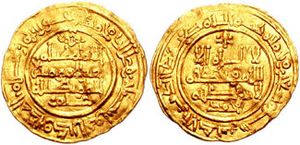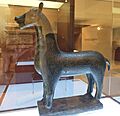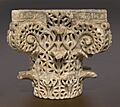Caliphate of Córdoba facts for kids
Quick facts for kids
Caliphate of Córdoba
خلافة قرطبة
Khilāfat Qurṭubah |
|||||||||||||||||||||||
|---|---|---|---|---|---|---|---|---|---|---|---|---|---|---|---|---|---|---|---|---|---|---|---|
| 929–1031 | |||||||||||||||||||||||
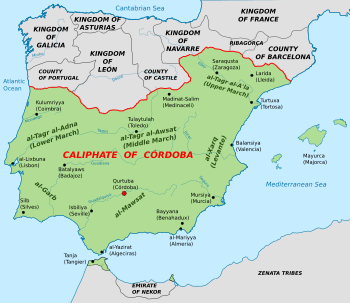
Caliphate of Córdoba circa 1000 AD
|
|||||||||||||||||||||||
| Capital | Córdoba | ||||||||||||||||||||||
| Common languages |
|
||||||||||||||||||||||
| Religion | |||||||||||||||||||||||
| Government | Theocratic monarchy | ||||||||||||||||||||||
| History | |||||||||||||||||||||||
|
• Abd ar-Rahman III proclaimed Caliph
|
929 | ||||||||||||||||||||||
|
• Disintegrated into several independent taifa kingdoms
|
1031 | ||||||||||||||||||||||
| Area | |||||||||||||||||||||||
| 1000 est. | 600,000 km2 (230,000 sq mi) | ||||||||||||||||||||||
| Population | |||||||||||||||||||||||
|
• 1000 est.
|
10,000,000 | ||||||||||||||||||||||
|
|||||||||||||||||||||||
| Today part of | Gibraltar (UK) Morocco Portugal Spain |
||||||||||||||||||||||
The Caliphate of Córdoba was a powerful Islamic state in what is now Spain and Portugal. It was ruled by the Umayyad dynasty from 929 to 1031. Its capital city was Córdoba. This period was known for its growth in trade and culture. Many beautiful buildings were also constructed during this time.
The Caliphate began when Abd ar-Rahman III, a ruler from the Umayyad family, declared himself caliph (a top religious and political leader) in 929. Before this, the region was known as the Emirate of Córdoba. The Caliphate eventually broke apart in the early 11th century. This happened during a civil war called the Fitna of al-Andalus. By 1031, the Caliphate split into many smaller, independent Muslim kingdoms called taifas.
Contents
History of the Caliphate
How the Umayyad Dynasty Rose to Power
The Umayyad family used to be the main rulers of the Islamic world. But they lost their power in Damascus in 750. After this, Abd ar-Rahman I came to Iberia (modern-day Spain and Portugal). In 756, he became the emir (ruler) of Córdoba. He defeated other local rulers and united the region into an emirate. His forces also expanded the emirate's size through military campaigns.
For a long time, the rulers of Córdoba used the title "emir" or "sultan." But in the early 10th century, a new threat appeared. The Fatimid Caliphate, a rival Islamic empire, was growing in North Africa. They also claimed to be the rightful caliphs. To challenge them, Abd ar-Rahman III declared himself caliph in 929. This made the Cordoban state a caliphate. Even after stopping the Fatimids, he kept this important title. The Umayyads in Spain believed they were more legitimate rulers than the Abbasid caliphs in Baghdad.
A Time of Great Success
The Caliphate of Córdoba became very prosperous in the 10th century. Abd ar-Rahman III brought al-Andalus (the Muslim-ruled part of Iberia) together. He also managed the Christian kingdoms to the north through force and diplomacy. He stopped the Fatimids from invading Morocco and al-Andalus. He secured important cities like Melilla in 927 and Ceuta in 931.
This period saw strong connections with other groups. These included Berber tribes in North Africa and Christian kings in Europe. The Caliphate also traded with France, Germany, and Constantinople. Under Abd ar-Rahman III, the government earned a lot of money. This money was used to pay the army, maintain public buildings, and support the caliph.
When Abd ar-Rahman III died in 961, his son, Al-Hakam II, took over. Al-Hakam II continued his father's policies. He was very interested in learning and books. The Caliphate reached its peak in learning and culture under his rule.
The Caliphate's Decline
The death of Al-Hakam II in 976 marked the beginning of the end. His son, Hisham II, was only 10 years old and too young to rule. Al-Mansur Ibn Abi Aamir, a powerful adviser, became the real power behind the throne. He made Hisham II caliph but kept the true power for himself. Almanzor isolated Hisham in Córdoba. He also brought many Berbers from Africa to al-Andalus to support his rule.
Hisham II became just a figurehead, a caliph with no real power. Almanzor's sons, Abd al-Malik al-Muzaffar and Abd al-Rahman Sanchuelo, continued to hold power. But when Abd al-Rahman Sanchuelo was away on a military campaign, a revolt broke out in Córdoba. He was removed from power and later killed.
After Abd al-Rahman Sanchuelo's death in 1009, the Caliphate faced a civil war. Many rivals claimed to be the new caliph. Violence spread across the region. The Hammudid dynasty also launched invasions. By 1031, the Caliphate completely fell apart. It broke into many independent taifas (small kingdoms). The last Caliph of Córdoba was Hisham III (1027–1031).
Military and Government Changes
Almanzor, the powerful adviser, made many changes to the army. He made the army more professional. This meant fewer local people had to serve in the military. Instead, he hired professional soldiers, often from other regions. These soldiers were loyal to him. This helped him keep control of the capital and launch many military campaigns.
He also changed how army units were organized. Before, different tribes had their own commanders. Almanzor mixed these units with soldiers from different backgrounds. This stopped them from uniting against him. However, after Almanzor was gone, these mixed units caused problems. They contributed to the civil war in the 11th century.
The army also included well-paid Christian soldiers. These mercenaries often served as Almanzor's personal guards. They also joined his campaigns into Christian lands.
To pay for this larger, professional army, more taxes were collected. Military campaigns also brought in loot and new lands. These lands were given to soldiers as payment. The Caliphate's army was funded by farmers who paid taxes. In return, they were excused from military service. The army also had volunteers who were very eager to fight.
Historians believe the Caliphate's army grew significantly during Almanzor's time. Some estimates say it had between thirty thousand and ninety thousand soldiers. This was a very large army for that time.
The main fighting force for campaigns was light cavalry (soldiers on horseback). These units were fast and good for surprise attacks. To counter this, Christian kingdoms in the north also started to create more mounted units.
The Caliphate also had a strong navy. It protected trade routes and transported troops. New naval bases were built, like the one in Alcácer do Sal. This base helped protect the Atlantic coast. The main base on the Mediterranean was in Almería.
Almanzor also made sure that officials in the government were loyal to him. He promoted officials who were not from the region. This helped him keep his power.
The Caliphate ruled by Almanzor was a rich and powerful state. Córdoba was a very large city, with over 100,000 people. Other cities like Toledo and Almería also had many residents. This was very different from the Christian areas to the north, which had few large cities. By the 10th century, most people in al-Andalus had converted to Islam.
Culture and Learning
Córdoba was a major center for culture and learning in al-Andalus. Scholars translated ancient Greek texts into Arabic, Latin, and Hebrew. During Al-Hakam II's rule, the royal library had an amazing 400,000 to 500,000 books! This was huge compared to other libraries in Europe at the time.
There were many advancements in science, history, geography, and philosophy. The Caliphate's wealth attracted many travelers, diplomats, and scholars. They brought new ideas in art, music, and literature from other Islamic lands. Córdoba became a hub of high society. Poets wrote for the caliph's court. Other poets wrote about nature and love. A new style of poetry, Muwashshah, became popular. It mixed Arabic and local Romance languages.
Writers also began to record the history of the Umayyad dynasty in al-Andalus. These histories also described the land and its people.
Christians and Jews also played a part in the culture of al-Andalus. However, they had to show respect for the Arabic language and Islam. Hasdai ibn Shaprut was a famous Jewish scholar and doctor. He worked in the caliph's court. He also supported Jewish learning, which led to a "Golden Age" of Jewish culture in the region.
Latin culture declined as local Christians adopted Arabic customs. But Christians from al-Andalus traveled to other parts of Europe. They helped share knowledge from al-Andalus with the rest of the continent.
Some upper-class women also received education. They wrote poetry and studied religion. For example, 'Aisha ibn Ahmad wrote poetry and founded libraries. Lubna, a slave, worked as a scribe and librarian for Al-Hakam II. Fatima bint Yahya al-Maghami was a well-known expert in Islamic law. She taught both men and women.
Arts and Crafts
The caliph's workshops produced many luxury items. These were used at court or given as gifts to important guests. Many of these objects are now in museums and cathedrals in Europe.
Famous items from this time include carved ivory boxes. They have beautiful designs of plants, animals, and Arabic writing. Examples are the Pyxis of al-Mughira and the Leyre Casket. The workshops also made fine silks, ceramics, and leather goods. Metalwork was also common. The "Cordoba Stag" is a famous bronze fountain spout shaped like a deer. It is now in a museum in Córdoba.
Marble was used for decorations in buildings. Carved marble capitals (the tops of columns) were very popular. They had detailed plant designs in a unique style. These capitals were later reused in other buildings.
Amazing Architecture

Abd ar-Rahman III showed his power by building a huge and fancy palace-city. It was called Madinat al-Zahra (also known as Medina Azahara). It was built just outside Córdoba, starting around 936. The city had grand halls, a large mosque, government offices, homes, gardens, and workshops.
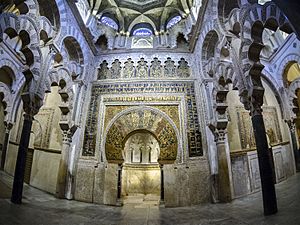
He also made the courtyard of Cordoba's Great Mosque bigger. He built its first true minaret (a tower for the call to prayer). This square-shaped minaret became a model for other mosques in the region. Al-Hakam II, Abd ar-Rahman III's son, further expanded the mosque's prayer hall after 962. He added beautiful arches, decorative domes, and a richly decorated mihrab (a niche showing the direction of prayer). This mihrab had gold mosaics from the Byzantine Empire.
A smaller but important building from this time is the Bab al-Mardum Mosque in Toledo. It has unique ribbed domes and horseshoe arches. Its outside walls have Arabic writing carved in brick. Other buildings from this period include old city gates in Toledo, the Castle of Tarifa, and the Caliphal Baths in Cordoba.
In the 10th century, northern Morocco was also influenced by the Cordoban Caliphate. The Caliphate helped expand the Qarawiyyin and Andalusiyyin mosques in Fes. They added square minarets, just like the one in the Great Mosque of Cordoba.
Economy and Trade
The Caliphate had a strong and varied economy. Trade was very important. Muslim trade routes connected al-Andalus with the rest of the world through the Mediterranean Sea. Industries like textiles, ceramics, glassware, and metalwork grew. Farmers also introduced new crops like rice, watermelon, and bananas. They used water wheels to water their fields.
Many of the main merchants in the Caliphate were Jewish. Jewish merchants had large trade networks across the Mediterranean. They relied on strong personal and family connections to do business. Jewish families from al-Andalus, Cairo, and other places married each other. This helped build trust for trade. The economy in Córdoba was also strong because it had a good system of coinage.
Córdoba was also a major center for the slave trade in the Mediterranean. Its location helped it connect with suppliers in Northern Europe and buyers in Muslim lands. The Caliphate's government also relied on slaves. Slaves owned by the caliph held important positions in his household and army. They made up a large part of the Caliphate's military.
Society and Religion
The Caliphate had a very diverse society. People came from different ethnic groups, cultures, and religions. A small group of ethnic Muslims of Arab descent held the top religious and ruling jobs. Other Muslims, including converts, were found throughout society.
Jews made up about ten percent of the population. They were often involved in business and intellectual work. Christians, called Mozarabs, were a minority. They were in a lower social class and paid higher taxes. They had fewer civil rights. However, they were still influenced by Muslim culture.
Arabs were at the top of the social ladder. Muslims had a higher social standing than Jews, and Jews had a higher standing than Christians. Christians and Jews were considered dhimmis. This meant they had to pay a special tax for protection.
By the 10th century, about half of Córdoba's population was Muslim. This number grew to 70 percent by the 11th century. This was mostly due to Muslims moving in from other parts of Iberia and North Africa. The status of Christians declined compared to their earlier rule. But the status of Jews improved. Jewish communities gained more freedom and wealth under Umayyad rule.
Population
Historians estimate that the capital city of Córdoba had around 450,000 people. This made it the second-largest city in Europe at that time. Many people who converted to Islam, called Muwallad, made up the majority of the population. They were often at the lower levels of society. There was also a constant flow of Berber people migrating from North Africa.
Rulers of Córdoba
| Caliphs of Córdoba | |
| Umayyad Caliphs of Córdoba | |
| Caliph | Reign |
|---|---|
| ʿAbd al-Rahmān III al-Nāṣir li-Dīn Allāh | 929 – 961 |
| Al-Ḥakam II al-Mustanṣir bi-llāh | 961 – 976 |
| Hishām II al-Muʾayyad bi-llāh | 976 – 1009 |
| Muhammad II al-Mahdī bi'llāh | 1009 |
| Sulaymān al-Mustaʿin bi'llāh | 1009–1010 |
| Hishām II al-Muʾayyad bi-llāh | 1010 – 1013 |
| Sulaymān al-Mustaʿin bi'llāh | 1013–1016 |
| ʿAbd al-Raḥmān IV al-Murtaḍā bi-llāh | 1017 |
| Hammudid Caliphs of Córdoba | |
| ʿAli ibn Ḥammud al-Nāṣir li-Dīn Allāh | 1016–1018 |
| Al-Ma'mun al-Qāsim ibn Ḥammud | 1018–1021 |
| Yaḥya ibn ʿAli ibn Ḥammud al-Muʿtali bi-llāh | 1021–1023 |
| Al-Ma'mun al-Qāsim ibn Ḥammud | 1023 |
| Umayyad Caliphs of Córdoba (Restored) | |
| ʿAbd al-Rahmān V al-Mustaẓhir bi-llāh | 1023–1024 |
| Muhammad III al-Mustakfi bi-llāh | 1024–1025 |
| Hammudid Caliphs of Córdoba (Interregnum) | |
| Yaḥya ibn ʿAli ibn Ḥammud al-Muʿtali bi-llāh | 1025–1026 |
| Umayyad Caliphs of Córdoba (Restored) | |
| Hisham III al-Muʿtad bi-llāh | 1026–1031 |
| End of the Caliphate | |
Images for kids
-
The Pyxis of al-Mughira, a carved ivory casket made at Madinat al-Zahra dated to 968
-
Plant designs and figures carved in ivory on the Leyre Casket, made in 1004–1005
See also
 In Spanish: Emirato de Córdoba para niños
In Spanish: Emirato de Córdoba para niños
- History of Islam
- History of Gibraltar
- History of Algeria
- History of Portugal
- History of Morocco
- History of Spain
- List of Sunni Muslim dynasties
- Martyrs of Córdoba
- Timeline of Septimania
- Umayyad conquest of Hispania


